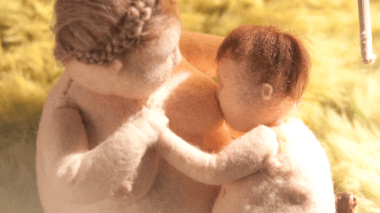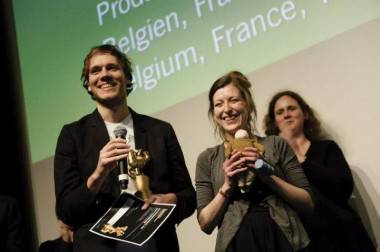An Interview with “Oh Willy…” Co-Director Marc Roels
Oh Willy… is a brilliantly-crafted stop-motion animation created by Belgium-based duo Emma de Swaef (originally from Belgium) and Marc Roels (originally from south Africa).
The story follows Willy, a naïve and soft-hearted fellow dealing with the death of his Mother, coming to terms with a life fraught with confusion and unusual choices. Oh, and by the way, it’s all set in a nudist colony. This surreal journey has brought many a tear, chortle and raised eyebrow to audiences across the world.
The short has had the stop-motion community and animation festivals talking with its innovative use of materials and unashamedly bizarre narrative. Skwigly had the opportunity to talk to co-director Marc Roels at the recent Stuttgart festival.
Can you tell us a little about how you came up with the story for Oh Willy…?
My co-director Emma de Swaef has a background in documentary filming, so the initial idea came from her graduation film in which we were following an office worker called Willy. He turned out to be quite a tragic figure – we were just doing a documentary about the average bureaucrat in Belgium and we came across this guy. He seemed very interesting, kind of passive, gentle character who went though a lot of tragedy. During the documentary he lost his job and it had quite an effect on us. So we always referred back to him when we were writing scripts for the film. He was the initial spark for this film. We did her graduation film together – which is basically a cruder version of how this film is now – then further developed his character, so the chatter came from that. The rest of the film we pieced together through research we were doing for other projects, and we brought it all together and made a film out of it.
The use of felt is something that has really drawn people to the film, can you tell us why you decided to work using this material?
The film is all made out of felt, wool or a textile of some sort, there’s no other material; The base materials were obviously wood or whatever we found and was useful, but it was always covered in textiles. We created the forest sets using wool in this way and we came up with a look for the tress in the forest that worked really well, especially with the lights, so we just thought that was a really good look for the film. From then on, any other object we came up with couldn’t just be done in plasticine, we had to make sure the style was consistent – but it wasn’t something we preconceived from the beginning.
You mentioned there were problems with the material contracting and shrinking due to the heat from the lights?
Yes, wool is an organic substance so it reacts to temperature, it expands and contracts much more than a synthetic material would, so if we were doing a shot on the film we had to complete it within one day or as quick as possible as it would be changing constantly throughout the shot. As every shot had to be done in one day, it kind of restricted us in terms of story telling – we couldn’t use long deliberate shots, the animation had to be focused and quite small, we had to pull everything down to a very focused core – so the material really dictated how the story was told. All these ideas we had for these long, involved shots we had to pare down, in essence, to what we could control technically.
You also mentioned you got in contact with Mackinnon & Saunders for help?
We did and they were more than happy to help us. They had just come off working on the puppets for Fantastic Mr. Fox so they had a lot of material lying around. We didn’t do all the puppets there, we were just there to create a prototype for the model we would be using, so we made two puppets there and based on those two we made all the other characters in the film. Whilst we were there we learned a lot about all the things they’ve tried; They had also tried to make puppets with felt, but it didn’t turn out so well and they had to abandon it because it’s a very inflexible material to work with – the puppets don’t have a full range of motion, so either you scrap the puppets and you find a new material to work with, or you change your way of telling the story, which is what we did.
But Mackinnon and Saunders were great, we actually got a lot of materials from them, like the feet of the characters are actually feet that came of the characters in Corpse Bride. At one point in the film there are two little boys that beat up the main character when he’s a kid, one of them has ginger hair and that’s actually hair from Fantastic Mr Fox. So we gave him a George Clooney hair cut because he came from the character Clooney voiced.
That’s really great. How did you get funding for this film?
Well in Europe it’s a different system, so part of our funding came from Belgium – they have a very good grant system in place for independent films – and the other half came from France who subsidise films all the time. They really believed in us, I mean commercially the film wasn’t going to be big shaker, it’s more a cultural thing – they saw the importance in that and decided to give us a grant. Holland was also a producer of the film, which meant for the film’s production we had to travel around a lot. All the sets were constructed in France, then we hired a big truck and we shipped everything out to Belgium for the shoot. We then shot everything there, then when the film was done and edited everything had to go to Holland to do all the sound work. It was a pan-European effort!
So the film has quite a dark humour to it, is that more you or Emma?
I don’t know, we don’t really think too heavily about that. Emma and I have very similar tastes and we just did things we thought were funny or interesting in some way. Belgium does have this tradition of surrealist art so were obviously informed by that, but we are influenced by everything. The first part of the film we got from Diane Arbus’s photo series of nudists in America in the 50s and 60s, which is kind of humorous but also has a dark edge to it. We were really drawn to that. Someone else mentioned that we had references to Tintin – there is one book were he is abducted by a huge Yeti and that also kind of informed us about where the movie went. Nothing was really conscious, we just drew on stuff we admired, just piecing it together with no set trajectory for the story.
I understand it’s had quite a lot of different audience reactions?
It really depends. I was expecting a less vocal reaction in Germany but I was blown away, they reacted really well. It’s been different all over. We just finished our festival run in the states, Americans are really very inquisitive, there were a lot of questions and a lot of confusion but we won quite a few prizes there. There was a weird tension with people really not getting it, but then talking to them maybe they just weren’t used to a film like this. In France everyone was very nonplussed, there wasn’t much of a reaction strangely. I can’t put my finger on it why one audience reacts one way and another audience reacts another, were just pleased if it’s positive.
It’s been doing surprisingly well, the film has snowballed. We’ve seen other films that we think are just as good but sometimes one film just catches on and sort of has a life of its own and we were happy it was ours.
You mentioned that Willy came from a character from an earlier project. Are there any characters you feel particularly akin to?
Not really, in this film it’s really about the main character Willy, all the other characters are very much all there to give that character a direction to progress the narrative. Maybe the character of the yeti, he was this very violent, unpredictable character that we wanted in there – kind of anarchic, we just wanted a different energy to go against Willy who is very passive. If you go to most film schools or seminars they will tell you your character has to be pro-active, to make decisions, and has to go from A to B, but we wanted a character that was very passive, didn’t want to do anything except be left alone but was forced into situations. So Willy is always reacting to what he has to come up against, in a very passive way, so we decided we were really going to throw the works at him. In the end just being put together with this kind of violent, unpredictable kind of beast and how he would react to that was something we found interesting for the film.
So what are you working on now?
The next film will also be a short film, made in much the same technique. It’s going to be set in colonial Africa, between 1890-1910, when European countries were going into Africa and picking countries for themselves. We thought that was interesting subject matter, a very absurd part of European history that has been dealt with very seriously in the past, historically it’s very they-did-this-and-that, but from an animator’s point of view it’s extremely absurd. It’s almost cartoon-like, a megalomaniac grab for power, so we may do something like that narratively but we’re still very much developing it. We’ve just got the first portion of funding so it’s not going to be any time soon. Hopefully end of next year sometime, but who knows?
Subsequent to this interview Oh Willy… then went on to win the top prize in Stuttgart’s international program. This is a great film and is still doing the rounds in many festivals, if you can get to see it I strongly suggest it.



